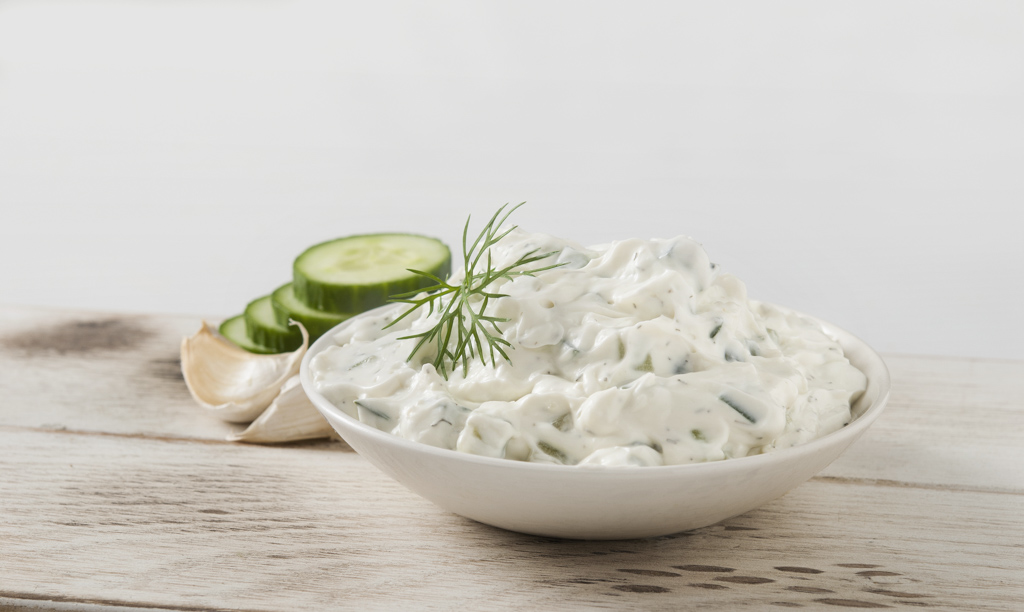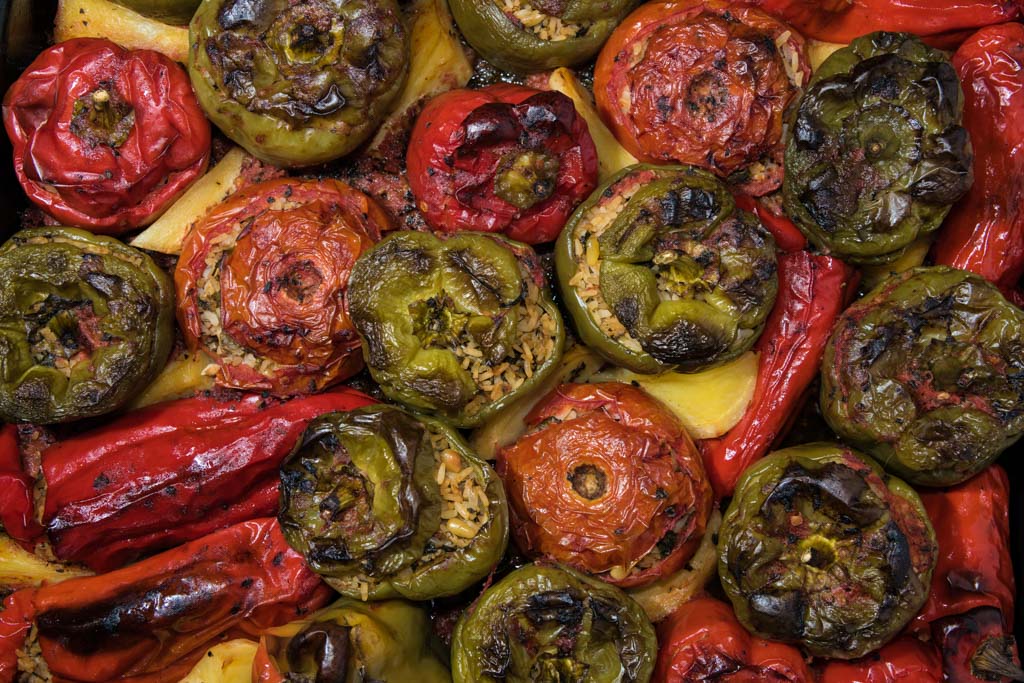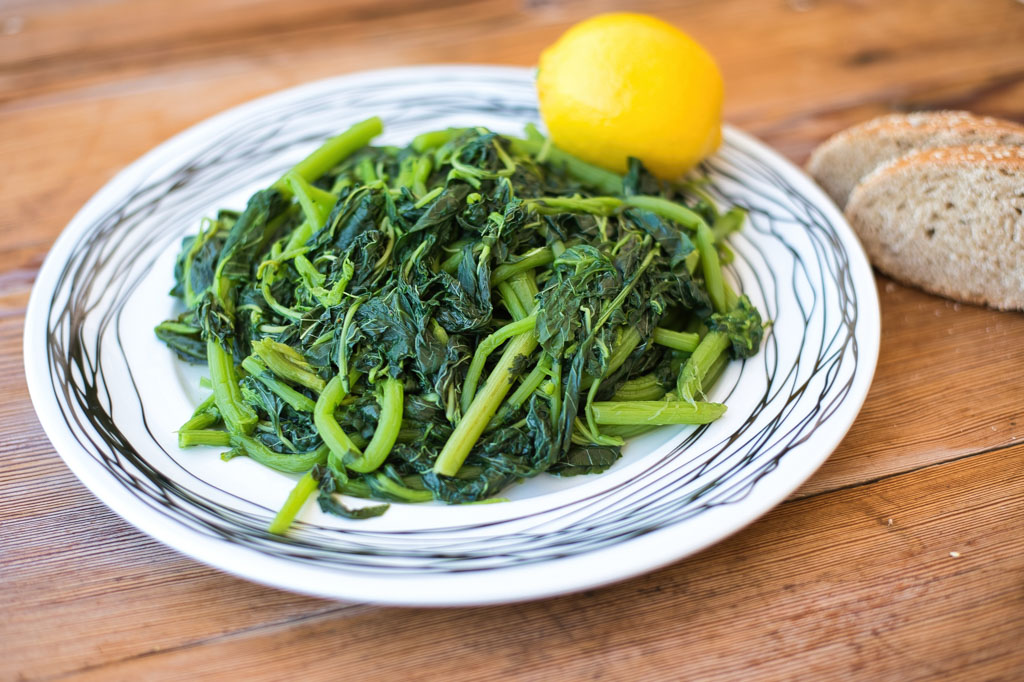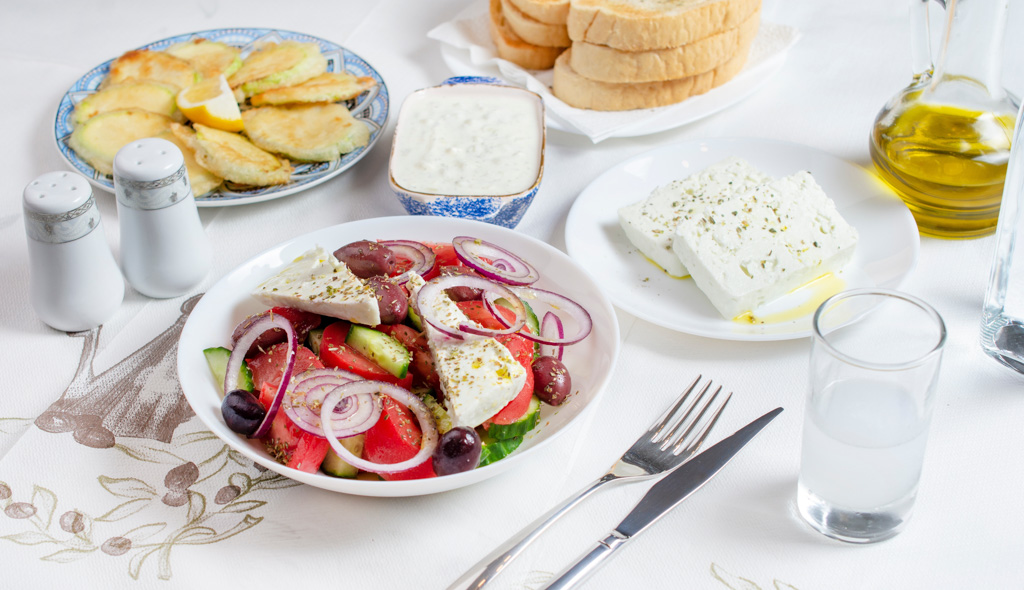Greece’s vegetarian cuisine is every bit as memorable as the crisp fried calamari, the savory moussaka, and the grilled lamb, and in some cases, it’s also even more famous. These iconic Greek dishes tell the story of Greece’s culture. They reveal both the bounty of the land, and also the spirit of the people, never wasteful and always appreciative of nature’s gifts. The vegetarian cuisine of Greece in large measure also reflects the culture’s strong connection to religion; the most devout Orthodox Christians fast not only in the four main fasting periods (pre-Easter Lent being the best known), but also each Wednesday and Friday.
Here are several famous Greek dishes for you to try on your next visit to Greece.
Tzatziki

This is perhaps one of the most famous of Greek dishes beyond the borders of Greece. So refreshing, it is also very simple. Yogurt is very common throughout Greece. Tzatziki is fresh strained thick and creamy yogurt, scented with garlic to taste and mixed with chopped cucumbers that have been salted and drained to remove the liquid (so the tzatziki stays thick). Fresh dill is a fragrant addition. Tzatziki is not a dish in and of itself, but a frequent and important side dish – with Gyros, with fried Calamari, and with dolmadakia it really shines.
Greek Salad
There is hardly any Greek restaurant in Germany or a diner in New York that doesn’t feature Greek Salad on the menu, and it’s very popular in many other countries also. But the versions vary from palace to place. In Greece, it is not called a Greek Salad but rather a “Horiatiki” – a “Village Salad.” It is made at home and is also available in most every taverna or even fast food place, and plenty of more elegant restaurants, too.
 There may be some small regional or personal variations to a Horiatiki Salad, but all agree on some essentials – juicy peak-of-season tomatoes, crisp cucumbers, a little onion (round in slices or fresh green onions), feta, olives (usually oblong black Kalamata olives), extra virgin olive oil, and some fragrant oregano. A Greek village salad is the perfect accompaniment to a simple grilled meat dish or also beside some fresh caught fish. But with some crusty bread, a good Greek salad can be a meal in itself.
There may be some small regional or personal variations to a Horiatiki Salad, but all agree on some essentials – juicy peak-of-season tomatoes, crisp cucumbers, a little onion (round in slices or fresh green onions), feta, olives (usually oblong black Kalamata olives), extra virgin olive oil, and some fragrant oregano. A Greek village salad is the perfect accompaniment to a simple grilled meat dish or also beside some fresh caught fish. But with some crusty bread, a good Greek salad can be a meal in itself.
Dolmadakia
Speaking of dolmadakia, this is another famous dish, but unfortunately, many people know it best from the can. As tinned foods go, dolmadakia is healthier than many and fairly tasty, too. But in Greece, you only ever see the real thing – fresh, hand rolled grape leaves stuffed with rice and herbs.

Dolmadakia are part of the spirit of letting nothing go to waste- when vintners prune their vines, those tangy-tasting leaves are put to excellent use. The main ingredients are short grained rice and plenty of fresh spring onion, parsley, and dill. Then there are all kinds of personal variations, also depending on the region. In Crete, many add fresh mint. Descendants of Greeks from Asia Minor may add small sweet currants and pine nuts for a richer version.
Dolmadakia often appear on a meze table as they are perfect for snacking. Tzatziki or simply thick yogurt is a perfect accompaniment.
Gemista
Here is another dish of something stuffed with rice. The very name Gemista comes from the Greek word “Gemiso” – to stuff.

What exactly is stuffed? Pretty much always fresh green peppers and tomatoes are the stars. But some home cooks also take the time to hollow out fresh tender zucchini, eggplants, and even whole onions. The more variety, the better. Each vegetable adds its flavor to the others as they slowly roast together in the oven. The stuffing is much like that of dolmadaki – rice, herbs, and chopped onions – except that it nearly always also includes a lot of fresh grated tomato. There is almost no water usually- all of the moisture is provided by the great bunches of herbs, grated onions, and tomato.
This is a delicious dish any time, but a great summer favorite, as it is even better when it gets to sit out at room temperature instead of having it hot out of the oven.
Gemista is part of a strong tradition of similar dishes from cuisines of the Levant, and it is often thought that it was the Greek refugees of Asia Minor who introduced this dish when they arrived in mainland Greece and on the islands in the 1920s. It is impossible to imagine the cuisine of Greece without it now.
Gemista is generally a main dish, the centerpiece of a perfect summer meal that needs nothing more than a slice of feta cheese or a spoonful of thick yogurt to make it complete.
Horta
“Horta” – that is a hard “h” – is simply weeds. It is the generic word for weeds or greens and it means any wild or cultivated seasonal green, or ideally, a mixture. Every classic taverna menu will offer Horta, and what it is depends on the season.That would be sweet and tender large-leaved “Vlita” in summer. But winter is the best season, with the bitter greens of “Radikia” or the flavorful and delightfully-textured “Zoches.”

Horta has its origins in the resourcefulness of people living on the land. Wild foraged greens were a staple of the Mediterranean diet and a source of nutrition available to all. This salad is therefore an important part of Greece’s culinary heritage.
Regional variations shine. Crete for instance has the delicious and slightly bitter “Stamnagathi” and many wild-gathered delights. These you may be lucky to find at a family-owned mountain taverna where the gathering of wild greens is a popular seasonal activity.
Horta is served simply boiled, salted and doused with extra-virgin olive oil and a squeeze of fresh lemon juice.
This simplest of salads is almost never served alone but a side dish with fish, meat, or on Crete even fried snails.
Vegetarian Cuisine in Greece and the Mediterranean Diet
These delicious vegetarian dishes celebrating local, seasonal produce are sustainable, healthful, and most of all they offer a delicious and authentic taste of Greece’s rich culinary traditions. Have you tried any of these simple staples of Greek homestyle cooking?





